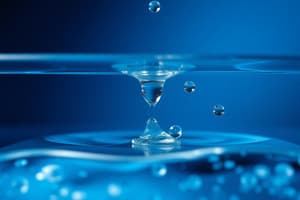Podcast
Questions and Answers
What is surface tension?
What is surface tension?
- The tendency of liquid surfaces at rest to shrink into the minimum surface area possible (correct)
- The tendency of liquid surfaces to expand into the maximum surface area possible
- The tendency of liquid to sink to the bottom of a container
- The tendency of liquid to evaporate quickly
What allows objects with higher density than water to float on its surface?
What allows objects with higher density than water to float on its surface?
- Adhesion
- Cohesion
- Surface tension (correct)
- Buoyancy
What causes surface tension at liquid-air interfaces?
What causes surface tension at liquid-air interfaces?
- Equal attraction of liquid molecules to each other and to the molecules in the air
- Greater attraction of liquid molecules to the molecules in the air than to each other
- Greater attraction of liquid molecules to each other than to the molecules in the air (correct)
- No specific attraction between liquid molecules and air molecules
What is the net effect of surface tension on a liquid's surface?
What is the net effect of surface tension on a liquid's surface?
What is the second primary mechanism contributing to surface tension?
What is the second primary mechanism contributing to surface tension?
Flashcards
Surface tension
Surface tension
The tendency of liquids to minimize their surface area.
What causes surface tension?
What causes surface tension?
It arises from the stronger attraction between liquid molecules compared to their attraction to air molecules.
How does surface tension help things float?
How does surface tension help things float?
It allows objects denser than water, like a boat, to float due to the 'skin' on the water's surface.
How does surface tension behave?
How does surface tension behave?
Signup and view all the flashcards
What is the effect of surface tension?
What is the effect of surface tension?
Signup and view all the flashcards
Study Notes
Surface Tension
- Surface tension is a property of liquids.
- It describes the tendency of a liquid's surface to resist external forces and minimize its surface area.
- This resistance is due to the cohesive forces between liquid molecules.
Floating Objects
- Objects with higher densities than water can float on its surface due to surface tension.
- This happens because the surface tension of the water creates a thin, elastic-like skin that can support the weight of the object.
- This effect is more pronounced for smaller objects.
Liquid-Air Interface
- Surface tension at the liquid-air interface is caused by the imbalance of intermolecular forces.
- Liquid molecules inside the bulk of the liquid experience attractive forces from all directions.
- Molecules at the surface experience a net inward force due to the lack of attraction from above the surface.
- This imbalance creates a strong surface layer, resistant to disruption.
Surface Tension Effect
- The net effect of surface tension is to minimize the liquid's surface area.
- The cohesive force between the molecules creates a tight surface layer, reducing the area.
Secondary Mechanism
- The second primary mechanism contributing to surface tension is the attraction between liquid molecules and those of the surrounding medium.
- These forces, called adhesive forces, can be stronger than cohesive forces, causing the liquid to spread across the surface.
- This is why water, with stronger adhesive forces to glass than cohesive forces, wets a glass surface.
Studying That Suits You
Use AI to generate personalized quizzes and flashcards to suit your learning preferences.




